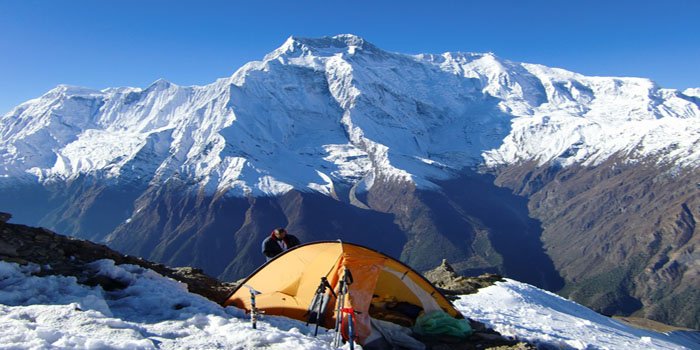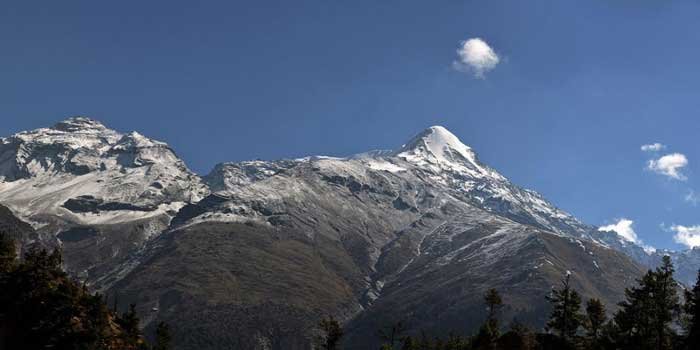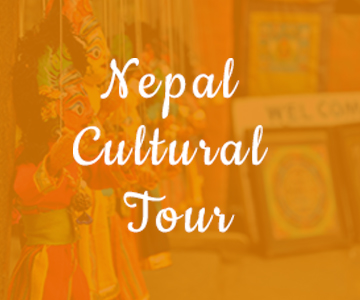Trip Introduction
Pisang Peak is rise on (6091m) in the central of Annapurna region and it is the most popular climbing peak in the region that is why we offer to specially this peak in our site. The Pisang Peak Climbing itself is quite technical. It is achievable for people with little or no experience in peak climbing. As the village is in the Annapurna region you will get to enjoy the views the region has to offer. Moreover, it offers trekking to the village and up to the base camp will allow you to getting on summit and see Nepal in all its beauty.
The Annapurna region is home to a ring of impressive mountains with ten peaks over 6000m and Mt Annapurna 1 is just over 8000m. Pisang Peak Climbing is a perfect trek and takes you through many different types of landscapes, through farmland and the rural Gurung villages. Furthermore, the trek to the base camp follows the Marsyangdi River and with the river, the mountains and the terraced farmland, it feels that with every turn is a new photo opportunity. Besides that, all of the Annapurna Region is now a conservation area project, this came into effect in 1986.
What's included
-
Four nights accommodation in a three star hotel in Kathmandu including breakfast. This will be for the two nights before trek and two night after trek.
-
All accommodation whilst on trek. Some rooms will be en-suite where they are available.
-
You are able to choose any food, any tea and coffee from menu for breakfast, lunch and dinner. This is not possible for the four nights camping where the group will have the same food.
-
Hire of camping equipment for the four nights camping.
-
Hire of Climbing equipment for group.
-
Private vehicle from Kathmandu to Besi shara and return after the trek.
-
Climbing Guide and leaders accommodation, and food.
-
Climbing Guide equipment and wages.
-
Cooking staff wages while camping .
-
Porter accommodation and wages while on trek.
-
Climbing Guide and guide and porters insurance.
-
Climbing Permits for group.
-
Trekking permits and national park fees for the trek. Trekking in the Annapurna region also requires a conservation permit which is also included.
-
An English speaking tour guide for Kathmandu sightseeing
-
Private transportation in Kathmandu including all airport arrivals and departures. This is also for the sightseeing tours.
-
All government taxes and Service charge.
-
Medical Supplies (Frist aid kit)
What's excluded
-
Nepal visa.
-
International airfare.
-
Travel and rescue Insurance
-
Hire of climbing equipment if not bringing own.
-
Food in Kathmandu.
-
Extra night hotel accommodation in Kathmandu if arrive early or late departure.
-
All the hotel accommodation or meals in Kathmandu.( in the case return early from trek due to any reason)
-
Personal expenses( bar bills, coke, beer, bottle of water, phone call, laundry service etc.
-
Tips for guide porter.
-
Day 1
Arrival in Kathmandu
Arrive into Kathmandu. You will be met by a member of Top of the World Treks and after a 45 minute bus journey to the heart of the city and check into the hotel there is time for a cup of tea, shower and then a chance to see the tourist district of Kathmandu by night as we go for dinner before an early night!
-
Day 2
Sightseeing in Kathmandu
A day in Kathmandu where we will take you to Swayambhunath which is a Buddhist stupa and Monastery, which is over 2000 years old and one of the oldest in the world. Here is a great chance to see across the valleys, see some monkeys and begin to learn about this fascinating country. The afternoon will be spent getting for the trek and some time to relax and make sure all the kit and packing is complete. Also the first time you can go shopping which in Thamel is an adventure in itself!
-
Day 3
Kathmandu to Bulbule Trekking time 3 to 4 hours.
We will leave the hustle and bustle of Kathmandu early and drive to Besi Sahar. We follow the Trisuli and Marshyandi Rivers, it is about a five hour drive and enables us to take in the changing scenery as we head to more rural areas. Once at Besi Sahar we will commence our trek and the valley becomes a deep gorge. WE continue the narrow trail and then reach a long suspension bridge and then reach a large village called Khuldi. We follow the road until we reach our our first overnight stop at Bhulbhule.
-
Day 4
Bulbule to Jagat Trekking time 5-6 hours
We continue northwards up through the valley crossing many of Nepal famous suspension bridges we are also rewarded with many waterfalls along the way. Along with scenic river views we of course have mountain views and the peak Lamjung (6000m). We will arrive at the village of Bahundanda where we will stop for lunch. We then descend down to the river and then we climb back up the west bank and to the top of the ridge. We cross another suspension bridge and reach the village of Sange. We continue our gradual climb up, sometimes on the road until we reach our home for the night at Jagat. 1300m.
-
Day 5
Jaget to Dharapani Trekking Time 5-6 hours.
We walk gradually up until to Chamge and will cross a suspension bridge. We then climb steeply for about 2 hours through rhododendron and pine forest. The valley now becomes more deep. We arrive at the borders of Manang district and from here we will enter the Manang district and we arrive at a small village which is the foot of a large waterfall. We continue onto Dharapani where we will spend the night.
-
Day 6
Dharapani to Chame Trekking Time 4-5 hours.
We leave Dharapani and we climb through the forest to Bagarchhap, this is the first village on the trek with typical Tibetan architecture. The trail is now heading west and we can see the Manaslu ranges and sometimes Annapurna 2. We continue through the forests and we will arrive at Chame (2600m) and our views of the mountains will become perfect. Here we will spend the night.
-
Day 7
Chame to Pisang Trekking time 4-5 hours.
Today we will cross the river many times and we will pass through the narrow steep sided gorge nearing the village of Pisang (3200m). We climb up to the top of the ridge and here we will get our first views of the Manang valley. This is one of the best views of the trek.
-
Day 8
Pasang to Base CampTrekking Time 5 hours
Today we will head for the Pisang base camp of the peak. From the village we head up through the woods and fields to Kharka at 4380m. This considered the best place to camp. It is in a Alpine wood and it is here we will spend the first night in tents.
-
Day 9
Acclimatisation Day at Base Camp
An acclimatization day in base camp today. We will check all the equipment and ensure everyone is confident with the tools needed for the peak. We will be able to take in the amazing scenery and many photo opportunities at sunrise and sunset.
-
Day 10
Base Camp to High CampTrekking time 4 -5 hours.
We will head today for the high camp and pass the 5000m mark. Our high camp will be based at 5400m. We will reach the high camp by walking over the south west edge of the peak.
-
Day 11
Summit day down to Base Camp
Today is the big day. We will get up early to head for the summit. From the High Camp, the ridge takes us to the final snow-slop which is pretty vertical and more demanding to reach the summit. Our experienced guide will fixed the rope and help you to the summit of the Pisang peak. After this and many photos we will then descend back to the base camp for a well earned rest!
-
Day 12
Base Camp to Dhukur PokhariTrekking time 5 -6 hours.
We will leave the base camp and retrace our steps back down to the village of Dhukur Pokhari where we will spend the night.
-
Day 13
Trekking time 5- 6 hours.
Trek to Danakyu
-
Day 14
Trekking time 6 -7 hours.
Trek To Jagat
-
Day 15
Trekking time 6 – 7 hours.
Trek to Bhulbule
-
Day 16
Bulbule to Kathmandu
We will leave Bhulbule and drive back to Kathmandu. We will arrive in the hotel mid afternoon where you will be free to relax.
-
Day 17
Sightseeing in Kathmandu
Today after a leisurely start we will continue the tour of Kathmandu by visiting the largest Buddhist stupa in the world. Boudhanath stupa is a world heritage site and a lace which is an amazing place to see Buddhism and understand more about not only the religion but the Nepali culture.
-
Day 18
Departure Day
Return to theHome . Extra days are available at your own cost but we will be happy to arrange this for you.
IMPORTANT NOTE
Please be aware that your safety while in Nepal is our number one propriety. All itineraries are subject to change if there are safety concerns, health concerns of people in the group and/or weather concerns. This will be decided by the trek leader but we will always discuss the options with the group where possible to ensure peoples wishes are taken into account, however, the Treks leader decision is final.
Book our fixed departures
Equipments
Equipment Check – List
What clothing and equipment to take is one of the things that people worry the most about! We can advise you and help you and it does, of course, depend on the time of year, the area, the altitude and how many days you are trekking/climbing. When you arrive in Kathmandu we will go through all your equipment to ensure that it is correct for your trip. In Thamel (the tourist area of Kathmandu where you will be staying) there is an abundance of shops selling equipment and clothing so if anything is forgotten it can easily be sourced. It is also possible to hire climbing equipment and also items such as down jackets, and sleeping bags saving you a large purchase.
The following equipment list is suggested and necessary for both camping and tea house treks. Use this list as a guideline. The basic checklist should help you with your packing for any of our trips. Please remember that you should always try to keep the weight of your clothing equipment down to a minimum. Your packed trek bag should weigh no more than 15kg. Please remember this is just a checklist and you do not necessarily need to bring everything that is listed below.
GENERAL CHECKLIST
The following basic checklist should help you with your packing for any of our trips. Please remember that you should always try to keep the weight of your clothing equipment down to a minimum. Your packed trek bag should weigh no more than 15 kilograms. Please remember this is just a checklist and you do not necessarily need to bring everything that is listed below. Use your own experience and judgment to make your decision.
-Light and expedition weight thermal tops.
-Fleece jacket or pullover.
-fleece wind –stopper Jacket (optional)
-Waterproof shell jacket (preferably breathable fabric)
-Lightweight thermal gloves.
-Underwear (4)
-Shorts (2)
-Lightweight cotton long trousers/pants.
-Light and expedition weight thermal bottoms.
-Sun hat or Scarf.
-Warm fleece hat or light balaclava.
-T-shirt (2)
-Thin, lightweight (inner socks) (4).
-Sunglasses with UV protection.
-Sleeping bag rated to 0 degrees ¾ season
-Headlamp (eg Petzl) Spare bulbs and batteries.
-Small padlock to lock trek bag.
-Basic first aid kit(see First aid medicine bellow)
-Plastic bags –for keeping items dry inside trek bag.
-Daypack ( 35 to 40 litters/ 2500 to 3000 cubic inches.)
-Camping mattress, eg Thermarest pad.
-water bottles.
-Toiletries.
-Small wash towel.
-Footwear, appropriate to the trip.
-Waterproof shell trousers/pants. (Preferably breathable fabric)
TREKKING CHECKLIST
In addition to the items listed in our general checklist you will need to take the following on your trekking trip:
-Heavyweight gloves or mittens with a waterproof shell outer.
-Down vest and/ or jacket (optional).
-Fleece or wool trousers/ pants.
-Trekking/ hiking boots with spare laces.
-Thick, warm wool hiking socks (4)
– Footwear for around camp, eg running shoes and /or sandals.
-Gaiters (optional).
-Telescopic trekking/ ski poles (optional)
MOUNTAINEERING / CLIMBING CHECKLIST
In addition to the checklists for general trekking equipment above, and depending on the trip you have chosen, various items of mountaineering equipment may also be required, eg:
-Plastic boots and crampons (preferably step – in bindings ) with front points.
-Mountaineering Safety harness.
-Mountaineering Ice axe(60 to 75 cms long – depending on your height and personal preference).
-120 cms (4ft) climbing sling and to locking and unlocking caravans.
-Telescopic ski – sticks (optional).
-Prussik loops.
-Climbing helmet (optional).
-Jumper (Ascender & Descender).
-Pocket Knife.
-Headlamp.
-Mattress.
-Rope and Snow bars.
-Ice crew.
-High altimeter.
Most if not all of this equipment will be needed for any trip that crosses steep, snow-covered ground, or which includes sections of glacier travel. Our recommendation that you take no more than fifteen kilos of trekking equipment dose not include your plastic boots, ice axe, Crampons otherness/carabiners. During the trek, climbing hard wear will be carried separately from your trek bag, in group bags until needed.
EQUIPMENT RENTAL
To minimize your expense outlay for trekking and climbing equipment you may never use again, equipment rental and buying is possible in Kathmandu. You find them a lot cheaper than you find in Europe and the USA. Shops in Thamel offer a wide range of equipment available for rent and buy. Here is some cost which gives you an idea of the cost to rent in Kathmandu.
-Sleeping bags.
-Down Jackets.
-All-purpose mountaineering Ice axe (60 – 70 cms)
-Ice hummer.
-Climbing Harness.
-2 looking Carabiners, Climbing Sling.
-12 – point Crampons.
-Plastic Climbing boots.
-Helmet.
FIRST AID MEDICINE
-Bandage for Sprains.
-Plaster/ Band-aids.
-Iodine or Water filter(optional)
-Moleskin/ Second skin – for blisters.
-Antiseptic ointment for cuts.
-Anti-bacterial throat lozenges (with antiseptic)
-Aspirin/ paracetamol- general painkiller.
-Oral rehydration salts.
-Broad-spectrum antibiotic (norfloxacin or ciprofloxacin).
-Anti – diarrhoea medication (antibiotic).
-Diarrhoea stopper (Imodium – optional).
-Antibiotic for Giardia or similar microbe or bacteria.
-Diamox (Altitude sickness – can be bought in Kathmandu.
-Sterile Syringe set (anti-AIDS precaution).
– For more details please see our staying healthy topic.



